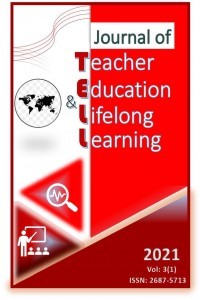Lifelong Learning Motivation Scale (LLMS):Validity and Reliability Study
Lifelong Learning Motivation Scale (LLMS):Validity and Reliability Study
Lifelong learning, motivation, scale, reliability validity,
___
- Adabaş, A. (2016). Bartın University graduate students' levels of having key competences in lifelong learning. Türkiye Council of Higher Education National Thesis Centre, (Thesis Number: 421734).
- Ata, N. (2006). Career and Leadership in the Information Age. Selçuk University, Institute of Social Sciences, Department of Business Administration, Division of Management and Organisation. Türkiye Council of Higher Education National Thesis Centre.
- Babanlı, N. (2018). Lifelong learning competences of trainees in adult education. Türkiye Council of Higher Education National Thesis Centre.
- Bağcı, Ş. E. (2007). Lifelong Education Policies in European Union Countries: A Comparative Study on Germany, Denmark and Turkey. Türkiye Council of Higher Education National Thesis Centre.
- Beycioglu, K. ve Konan, N. (2008). Lifelong learning and European education policies. Electronic Journal of Social Sciences, 24:369-382.
- Brown, T. A. (2015). Confirmatory factor analysis for applied research. New York: Guilford Publications.
- Bryce, J. (2006). Schools and lifelong learners. In J. Chapman, P. Cartwright & E.J. McGilp (Eds.), Lifelong learning, participation and equit. (pp. 243-263), Dordrecht: Springer.
- Büyüköztürk, Ş. (2002). Handbook of Data Analysis for Social Sciences, Ankara: Pegem Publishing.
- Büyüköztürk, Ş., Çakmak, E. K., Akgün, Ö. E., Karadeniz, Ş., & Demirel, F. (2017). Scientific Research Methods. Pegem Citation Index, 1-360.
- Byrne, B. M. (2011). Structural equation modeling with AMOS Basic concepts, applications, and programming (Multivariate Applications Series). Routledge, New York.
- Çepni, S. (2001). Introduction to Research and Project Studies. Erol Ofset Printing. Trabzon.
- Çiftcibaşı, F., Korkmaz, Ö. ve Karamustafaoğlu, S. (2020). Lifelong learning skills scale for secondary school students: Validity and reliability study. Erzincan University Journal of Faculty of Education, 22(1), https://doi.org/211–226.10.17556/erziefd.618167
- Demirel, M ve Coşkun, D. Y. (2012). Lifelong learning tendencies of university students. Hacettepe University Journal of Faculty of Education, 42, 108-120.
- Derrick, M. G. (2003). Creating enviroments conductive for lifelong learning. New Directions For Adult And Continuing Education. Wiley Periodicals S. 100
- Diker-Coşkun, Y. (2009). Investigation of lifelong learning tendencies of university students in terms of some variables Doctoral thesis. Hacettepe University Institute of Social Sciences, Ankara.
- Edwards, R., R.J.P.S. Usher, and L.L. J. Crowther (2008). Atroubled space of possibilities: lifelong learning and the postmodern. p. 58-67.
- Erdoğan, G. D. (2014). Factors affecting prospective teachers' lifelong learning tendencies. Doctoral thesis. Abant Izzet Baysal University, Bolu.
- Günüç, S., Odabaşı, H. F. ve Kuzu, A. (2012). Factors affecting lifelong learning. Gaziantep University Journal of Social Sciences, 11(2):309-325.
- Gür-Erdoğan, D. ve Arsal, Z. (2016). Development of the Lifelong Learning Tendency Scale (LLTS). Sakarya University Journal of Education, 6(1), 114-122. http://dx.doi.org/10.19126/suje.32361
- Gürkan, H. (2017). Examining the relationship between school principals' technology leadership competences and lifelong learning competences. Türkiye Council of Higher Education National Thesis Centre.
- Kara, M., Kukul, V. & Çakır, R. Self-regulation in Three Types of Online Interaction: How Does It Predict Online Pre-service Teachers’ Perceived Learning and Satisfaction?. Asia-Pacific Edu Res 30, 1–10 (2021). https://doi.org/10.1007/s40299-020-00509-x
- Karaca, O., Çalışkan, S. A., Dönmez, O. & Durak, H. İ. (2021). Lifelong Learning Attitude Scale (LILAS) for Healthcare Students in Higher Education: Development, Validity, Reliability Study. World of Medical Education. 20(62), 87-101.
- Karasar, N. (2007). Scientific Research Method, Nobel Publication Distribution.
- Knapper, C. & Cropley, A. J. (2000). Lifelong learning in higher education. London: Kogan Page
- Korkmaz, Ö., Usta, E., & Kurt, İ. (2014). Validity and reliability study of the Virtual Environment Loneliness Scale (SOYÖ). Hacettepe University Journal of Faculty of Education, 29(2), 144-159.
- Kulich, J. (1982) Lifelong education and the universities: a canadian perspective. International Journal of Lifelong Education, 1(2): 123–142
- Marsh, H. W., Balla, J. R., & McDonald, R. P. (1988). Goodness-of-fit indexes in confirmatory factor analysis: The effect of sample size. Psychological Bulletin, 103(3), 391–410. https://doi.org/10.1037/0033-2909.103.3.391
- Özçiftçi, M., M. Özçiftçi, & R.J.E.T.K.v.U Çakır (2015). Investigating teachers' lifelong learning dispositions and educational technology standards self-efficacy. 5(1): p. 1-19.
- Schermelleh-Engel, K., Moosbrugger, H., & Müller, H. (2003). Evaluating the Fit of Structural Equation Models: Tests of Significance and Descriptive Goodness-of-Fit Measures. Methods of Psychological Research, 8(2), 23–74.
- Tatlısu, B. (2016). Investigation of lifelong learning competences of pre-service teachers who do and do not do sports in terms of different variables. Türkiye Council of Higher Education National Thesis Centre.
- Ünal, F. ve Kalçık, C. (2017). Development of the scale of lifelong learning perception with historical series. Abant Izzet Baysal University Journal of Faculty of Education, 17(4), 1916-1937.
- Uzunboylu, H., ve Hürsen, Ç. (2011). Lifelong Learning Competence Scale (LLLCS): Validity and reliability study. Hacettepe University Journal of Faculty of Education, 41, 449-460.
- White, J.P. (1982). The aims of education re-stated. London: Routledge & Kegan Paul.
- Yaman, F. (2014) Investigation of teachers' lifelong learning tendencies (The case of Diyarbakır province). Türkiye Council of Higher Education National Thesis Centre.
- Yeşilyaprak, B. (2010). Guidance services in education. Ankara: Nobel Publishing.
- ISSN: 2687-5713
- Başlangıç: 2019
- Yayıncı: Ertuğrul USTA
Öğretmenlerin Dijital Yeterliliklerinin Farklı Değişkenlere Göre İncelenmesi
Muhammed Murat GÜMÜŞ, Volkan KUKUL
An inquiry and context-based activity supporting lifelong learning: Enzymes in Daily Life
Fatma ŞAŞMAZÖREN, Feride ŞAHİN
Lisansüstü Eğitim Tutum Ölçeğinin Geliştirilmesi: Geçerlik ve Güvenirlik Çalışması
Şaban ÇETİN, Kübra EKE, Hatice Büşra YILMAZ, Tülay Gül TAŞKIN GÖKÇE, Busra GORKAS
A Science Teacher's Teaching Moves about Low and High Achieving Students: A Belief System Approach
Lise Öğrencilerinin Coğrafi Bilginin Günlük Yaşama Yansımalarına İlişkin Değerlendirmeleri
Ufuk SÖZCÜ, Abdullah TÜRKER, Erkan DÜNDAR
Examination of Projects Prepared by Prospective Secondary School Mathematics Teachers Using Scratch
Selva Büşra TURAN, Ahmet ERDOĞAN
Misconceptions in 5-6 Year Old Children: Formation of a Cloud
